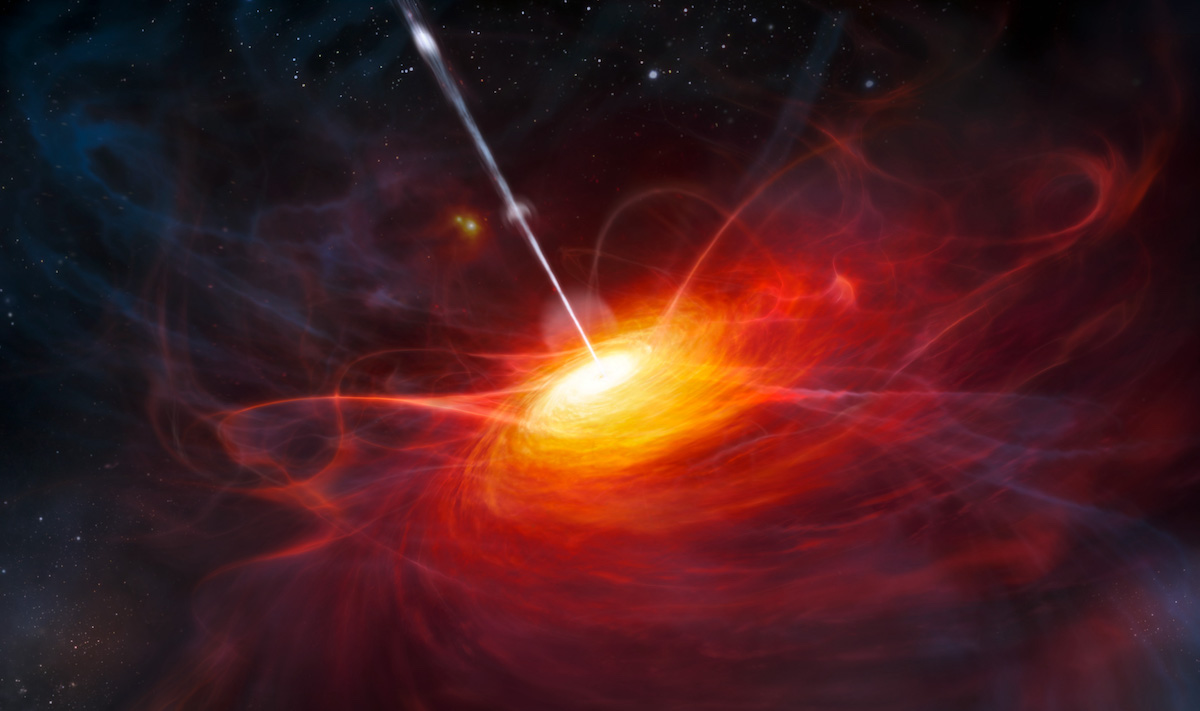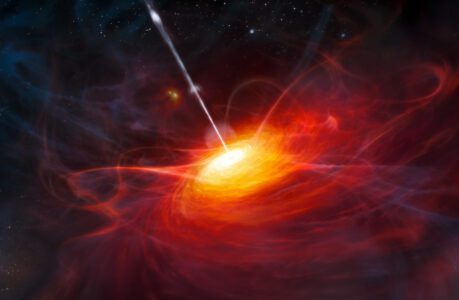Unraveling the Secrets of Active Galaxies: Journey into the Quasar Universe
Active galaxies, like quasars, have captivated the minds of astronomers and space enthusiasts for decades. These celestial objects, known for their extraordinary brightness and immense energy output, are some of the most enigmatic phenomena in the universe. In this comprehensive exploration, we will delve deep into the fascinating realm of active galaxies, with a special focus on quasars, shedding light on their nature, properties, and the mysteries that continue to shroud them.
The Cosmic Powerhouses
Active galaxies are cosmic powerhouses that defy our conventional understanding of galaxies. Unlike their tranquil counterparts, which simply twinkle in the night sky, active galaxies are dynamic and radiate intense energy across the electromagnetic spectrum. They are astrophysical anomalies that have intrigued astronomers since their discovery.
A Spectrum of Activity
One of the defining features of active galaxies is their spectrum of activity. These galaxies exhibit a wide range of energetic phenomena, which astronomers classify into different categories. At the heart of this diverse family of celestial objects are quasars, a subset of active galaxies that stand out as the most energetic and enigmatic members.
The Enigma of Quasars
What are Quasars?
Quasars, short for “quasi-stellar radio sources,” were first identified in the early 1960s. They appear as point-like sources of light in the sky and were initially mistaken for stars. However, as astronomers began to unravel their true nature, they realized that quasars are anything but stars.
Quasars are, in fact, supermassive black holes at the centers of galaxies, surrounded by a swirling accretion disk of hot gas and dust. What sets quasars apart from ordinary black holes is their prodigious energy output. They outshine entire galaxies, emitting intense radiation, including visible light, X-rays, and radio waves. This extreme luminosity makes quasars some of the most brilliant objects in the cosmos.
The Cosmic Powerhouses
The energy output of quasars is mind-boggling. Some quasars emit more energy in a single second than our entire Milky Way galaxy does in a year. This immense power stems from the gravitational energy released as material spirals into the supermassive black hole at the quasar’s core.
The accretion disk, where matter accumulates before its ultimate plunge into the black hole, reaches temperatures of millions of degrees, generating a searing inferno of radiation. This radiation escapes as powerful jets that extend for thousands of light-years into space, further contributing to the quasar’s brilliance.
A Cosmic Time Machine
Quasars hold another remarkable property—they serve as cosmic time machines. Their intense luminosity allows astronomers to peer into the distant past of the universe. The light from quasars travels across billions of years before reaching us, carrying with it a snapshot of the universe’s early days.
By studying quasars at various distances, astronomers can investigate the conditions and structures of the cosmos when it was only a fraction of its current age. This ability to observe the distant universe has provided crucial insights into the formation and evolution of galaxies and the overall history of the cosmos.
Unraveling the Quasar Lifecycle
Birth of a Quasar
The lifecycle of a quasar begins with the formation of a supermassive black hole at the center of a galaxy. While the exact mechanisms behind black hole formation are still a subject of research, it is believed that they grow over time by accreting matter from their surroundings. As material accumulates around the black hole, it forms the accretion disk, which eventually becomes the powerhouse of the quasar.
A Feast for the Black Hole
The prodigious energy output of quasars is the result of a feeding frenzy by the supermassive black hole at their core. Matter from the accretion disk spirals inward due to gravitational forces, gradually approaching the event horizon—the point of no return. As it nears this boundary, the matter accelerates to nearly the speed of light and emits intense radiation.
This radiation can vary in wavelength, from X-rays to radio waves, depending on the properties of the quasar’s accretion disk and the surrounding environment. The release of energy during this process is so intense that it can outshine the entire galaxy hosting the quasar.
Evolution and Dormancy
The lifecycle of a quasar is not a continuous burst of activity. Instead, it undergoes phases of intense brightness followed by periods of relative quiescence. During its active phase, a quasar is a voracious cosmic devourer, consuming nearby gas and stars. However, as the available material diminishes, the quasar’s brilliance wanes.
After the active phase, a quasar may transition into a dormant state, during which it emits significantly less energy. This dormancy can last for millions of years or longer, making it challenging to detect and study such quasars. However, they can still play a vital role in shaping the evolution of their host galaxies.
Quasars and Galaxy Evolution
Cosmic Engines
Quasars are not only fascinating in their own right but also have a profound impact on their host galaxies. The intense radiation and powerful jets emanating from quasars can influence the surrounding environment and trigger a cascade of events that shape the evolution of the galaxy.
One significant effect is the expulsion of gas from the galaxy‘s central regions. The energetic outflows generated by quasars can blow away the gas and dust needed for star formation. This process, known as “quasar feedback,” can effectively quench the galaxy’s star formation, transforming it from a star-forming galaxy into an elliptical or lenticular galaxy with aging stars.
The Coevolution of Quasars and Galaxies
The relationship between quasars and their host galaxies is a complex and symbiotic one. Quasar activity and galaxy evolution appear to be intertwined, with each influencing the other. While quasars can quench star formation, the evolution of the host galaxy can also impact quasar activity.
As the host galaxy evolves and its stellar population changes, the availability of material for the accretion disk alters. This, in turn, can reignite quasar activity, leading to another cycle of intense radiation and feedback. This coevolutionary process is still an active area of research, as astronomers seek to understand the intricate dance between quasars and galaxies.
Probing Quasars with Technology
Observing Quasars
Studying quasars is no small feat due to their immense distance from Earth and their relatively small size in the night sky. Astronomers employ a range of advanced technologies and techniques to observe and analyze these enigmatic objects.
One of the primary tools used in quasar research is the telescope, both ground-based and space-based. Telescopes equipped with specialized instruments allow astronomers to capture the faint light from quasars, dissect their spectra, and gather valuable data about their properties.
Spectroscopy: Unveiling the Secrets
Spectroscopy plays a pivotal role in quasar research. By dispersing the light from a quasar into its constituent colors, astronomers can examine its spectrum in detail. This provides information about the quasar’s composition, temperature, velocity, and redshift.
Redshift is a crucial parameter in quasar studies. It indicates how much the universe has expanded since the quasar’s light was emitted. By measuring the redshift of a quasar, astronomers can determine its distance and, consequently, its place in cosmic history.
Multi-Wavelength Astronomy
Quasars emit radiation across the entire electromagnetic spectrum, from gamma rays to radio waves. To capture this broad range of emissions, astronomers utilize a variety of detectors and observatories sensitive to different wavelengths.
For example, X-ray telescopes like NASA’s Chandra X-ray Observatory can detect the high-energy X-ray emissions from quasars, revealing the extreme conditions near the black hole. Radio telescopes, such as the Very Large Array (VLA), are used to study the radio waves emitted by quasars and their jets, shedding light on their magnetic fields and relativistic physics.
Computer Simulations
In addition to observational tools, computer simulations and modeling are indispensable in understanding the behavior of quasars and their impact on galaxies. Simulations allow astronomers to recreate the complex physical processes occurring in and around quasars, providing insights into their formation, evolution, and interactions with their host galaxies.
Unsolved Mysteries
Quasar Fueling Mechanisms
While astronomers have made significant progress in understanding quasars, many mysteries remain. One of the most profound questions is the precise mechanism that fuels quasars. How does matter efficiently make its way to the accretion disk, and what triggers the intense bursts of energy?
Several theories have been proposed, including the idea that galactic mergers or interactions play a role in channeling gas and stars toward the black hole. However, the exact mechanisms remain the subject of ongoing research and debate.
The Role of Supermassive Black Holes
Supermassive black holes are ubiquitous in the centers of galaxies, but not all of them become quasars. Understanding why some black holes remain dormant while others become active remains a major puzzle.
The interplay between black hole properties, such as mass and spin, and the surrounding environment may hold the key to unraveling this mystery. Studying a larger sample of black holes and their host galaxies is essential to gain a deeper understanding of this complex relationship.
The Early Universe
Quasars offer a unique window into the early universe, but some aspects of their formation and evolution in the early cosmos are still shrouded in mystery. How did supermassive black holes form and grow so quickly in the first billion years after the Big Bang? What role did quasars play in the cosmic web of galaxy formation?
These questions drive astronomers to push the boundaries of observation and theory, striving to unveil the secrets of the universe’s infancy.
Quasars and the Future
The Next Generation of Telescopes
The quest to understand quasars and their role in the cosmos continues with the development of next-generation telescopes and observatories. Technologies like the James Webb Space Telescope (JWST) promise to provide even deeper insights into quasar physics and their impact on galaxies.
The JWST, with its infrared capabilities, will allow astronomers to study quasars in unprecedented detail, peering through cosmic dust and observing the earliest quasars in the universe. Such observations may help answer questions about quasar formation and evolution in the early universe.
Citizen Science and Education
The study of quasars is not limited to professional astronomers. Citizen science projects and educational initiatives play a vital role in engaging the public and nurturing the next generation of scientists. Platforms like Zooniverse offer opportunities for enthusiasts to contribute to quasar research by classifying and analyzing quasar spectra.
Educational outreach programs also provide students and the general public with the chance to learn about the wonders of the universe and the mysteries of quasars. These efforts help ensure that the fascination with active galaxies, like quasars, continues to inspire future generations.
Conclusion
Active galaxies, particularly quasars, continue to intrigue and challenge astronomers. Their extreme luminosity, cosmic impact, and enigmatic behavior make them some of the most captivating objects in the universe. As technology advances and our understanding deepens, we move ever closer to unraveling the mysteries of these cosmic powerhouses, shedding light on the dynamic relationship between quasars and galaxies and gaining insights into the early history of the cosmos. The journey into the world of active galaxies and quasars is ongoing, promising further discoveries and revelations that will expand our knowledge of the universe and our place within it.

